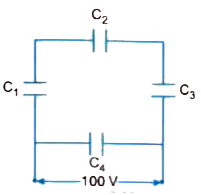An uncharged capacitor having capacitance C is connected across a battery of voltage V. Now the capacitor is disconnected and then reconnected across the same battery but with reversed polarity. Then which of the statement is INCORRECT
After reconnecting, heat energy produced in the circuit will be equal to two-third of the total energy supplied by battery
After reconnecting, no energy is supplied by battery
After reconnecting, whole of the energy supplied by the battery is converted into heat
After reconnecting, thermal energy produced in the circuit will be equal to 2CV2
The correct Answer is:B
Step by step video, text & image solution for An uncharged capacitor having capacitance C is connected across a battery of voltage V. Now the capacitor is disconnected and then reconnected across the same battery but with reversed polarity. Then which of the statement is INCORRECT by Physics experts to help you in doubts & scoring excellent marks in Class 12 exams.
Topper's Solved these Questions
- BOOK - PHYSICS GALAXY - ASHISH ARORACHAPTER - CAPACITANCEEXERCISE - NUMERICAL MCQS56videos
CAPACITANCE
- BOOK - PHYSICS GALAXY - ASHISH ARORACHAPTER - CAPACITANCEEXERCISE - ADVANCE MCQS26videos
CAPACITANCE
- BOOK - PHYSICS GALAXY - ASHISH ARORACHAPTER - CAPACITANCEEXERCISE - DISCUSSION QUESTIONS22videos
CAPACITANCE
- BOOK - PHYSICS GALAXY - ASHISH ARORACHAPTER - ATOMIC PHYSICSEXERCISE - Unsolved Numerical Problems39videos
ATOMIC PHYSICS
- BOOK - PHYSICS GALAXY - ASHISH ARORACHAPTER - CURRENT ELECTRICITYEXERCISE - All Questions389videos
CURRENT ELECTRICITY
Similar Questions
A capacitor of capacitance C is charged by connecting it to a battery of emf epsilon. The capacitor is now disconnected and reconnected to the battery with the polarity reversed. Calculate the heat developed in the connecting wires.
View SolutionWhen a parallel plate capacitor is connected across a d.c. battery. Explain briefly how the capacitor gets charged .
View Solution
Knowledge Check
- Question 1 - Select One
An uncharged capacitor is connected to a battery. On charging the capacitor
AAll the energy supplied is stored in the capacitorBHalf the energy supplied is stored in the capacitorCThe energy stored depends upon the capacity of the capacitor onlyDThe energy stored depends upon the time for which the capacitor is charged - Question 2 - Select One
A capacitor of capacitance C is connected across a battery of potential difference V. The energy stored in the capacitor is 12CV2
The energy supplied by the battery is 12CV2.ABoth A and R falseBBoth A and R true and R is not correct reason for ACA is true and R is falseDBoth A and R are true and R is correct reason of A.
A network of four capacitors, each of capacitance 15μF,is connected across a battery of 100 V as shown in the figure. Find the net capacitance and the charge on the capacitor C4.
 View Solution
View SolutionThe answer to each of the following questions is a single-digit integer ranging from 0 to 9. Darken the correct digit.
A parallel plate capacitor is connected to a battery and when it is fully charged, the energy stored in the capacitor is U1. Now it is disconnected from the battery and then reconnected to the same battery but with the polarity reversed. During the time capacitor is again charged, heat H is found to get dissipated from the capacitor. Calculate H/U1.View SolutionTwo capacitors of capacitance of 6μFand12μF are connected in series with a battery. The voltage across the 6μF capacitor is 2V. Compute the total battery voltage.
View SolutionTwo capacitors of capacitance of 6μFand12μF are connected in series with a battery. The voltage across the 6μF capacitor is 2 V.Compute the total battery voltage.
View SolutionA parallel plate capacitor of capacitance C0 is connected across a battery of voltage V. Calculate the change in energy stored in the capacitor if distance between both the plates is decreased to half of its original value.
View SolutionA 80μF capacitor is charged by a 50V battery. The capacitor is disconnected from the battery and then connected across another uncharged 320μF capacitor. Calculate the charge on the second capacitor.
View Solution

